
The Solar-Terrestrial Centre of Excellence (STCE) is a collaborative network of the Royal Observatory of Belgium, the Belgian Institute for Space Aeronomy and the Belgian Royal Meteorological Institute.
 |
Published by the STCE generally on thursday (this issue : 17 Nov 2011). The Solar-Terrestrial Centre of Excellence (STCE) is a collaborative network of the Royal Observatory of Belgium, the Belgian Institute for Space Aeronomy and the Belgian Royal Meteorological Institute. |
| Archive of the newsletters | Subscribe to this newsletter by mail |
On Nov 9th, 2011 Brewer 178 spectrophotometer of KMI was brought to the calibration laboratory of BIRA. Reason was that there were doubts about the validity of the so-called cosine response of the instrument. The Brewer measures the solar light intensity in the UV (286-363nm) on a horizontal surface. Ideally the response should follow the cosine of the angle of the incident light with the vertical. If this is not the case and the deviation is known, measurements can be corrected. Therefore a laboratory set-up was used to measure the deviation for this particular instrument.
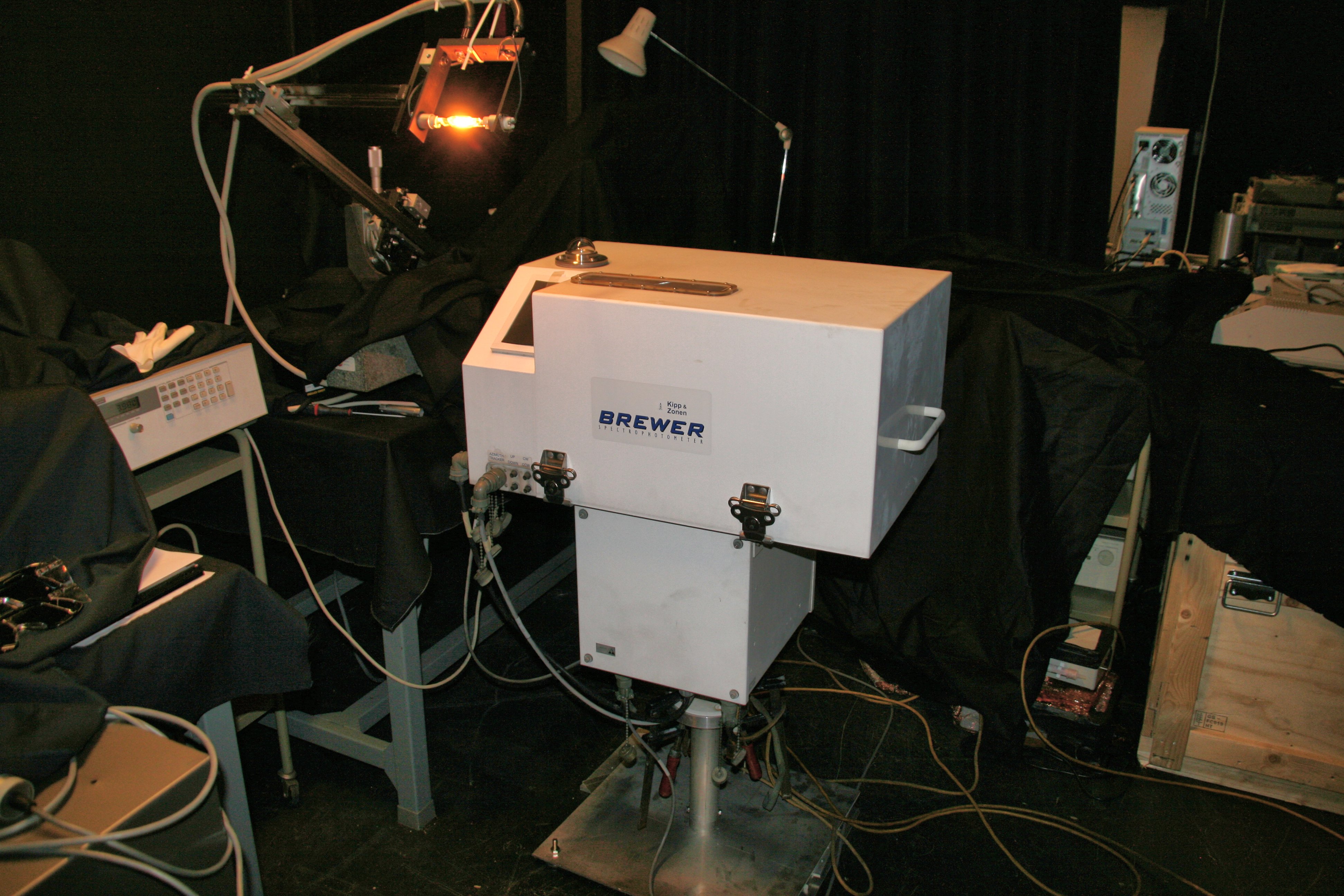
Brewer 178 of KMI in the BIRA lab during the measurement of the cosine response.
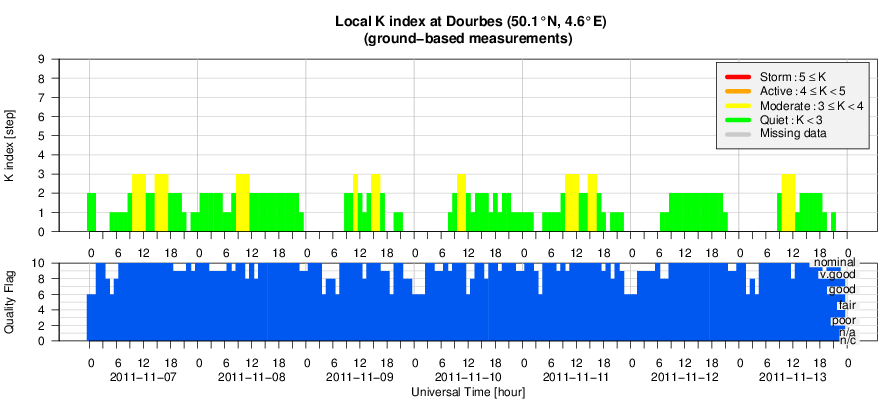
The ESA micro-satellite PROBA2 (see http://proba2.sidc.be) observes the solar corona from a low Earth orbit. This orbit includes an eclipse season, roughly from November to February in which a fraction of each 99min orbit is occulted by the Earth shadow.
On Nov 3, an X1.9 flare happened, according to NOAA it started 20:16, peaked at 20:27 and ended on 20:32. During these times, PROBA2 was just coming out of the Earth shadow and started observing the solar corona through the Earth atmosphere. In the Figure below we show a compilation of these unique observations.
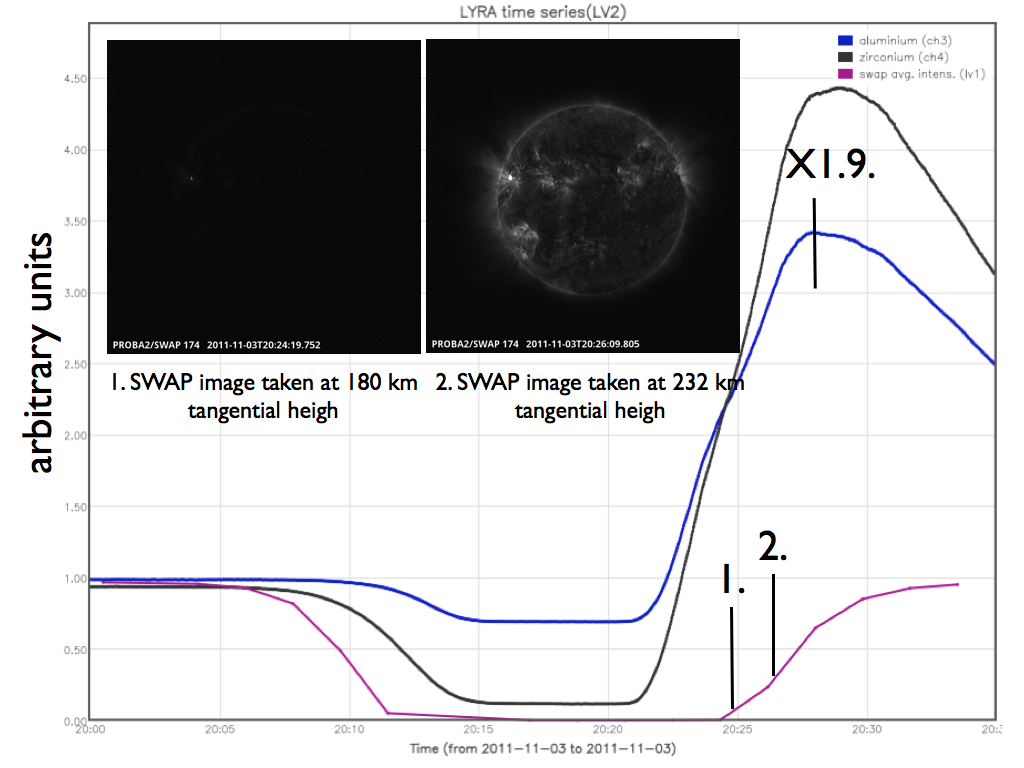
These observations will be used to check the penetration depth in the Earth atmosphere of the flare spectrum and to check the shape of the LYRA bandpasses.
Cycle 24 is now definitely on its rise towards the next maximum. The daily sunspot index already exceeded 100 on several occasions in the past two months. A significant fraction of those peaks was associated with large complex groups of McIntosh type E, which were the source of multiple M flares and even X flares.
Here we include a sample of USET quicklook images (subfields) of the most prominent active regions that crossed the solar disk over the past weeks (white-light and H-alpha).
Active region NOAA 11261

Active region NOAA 11263
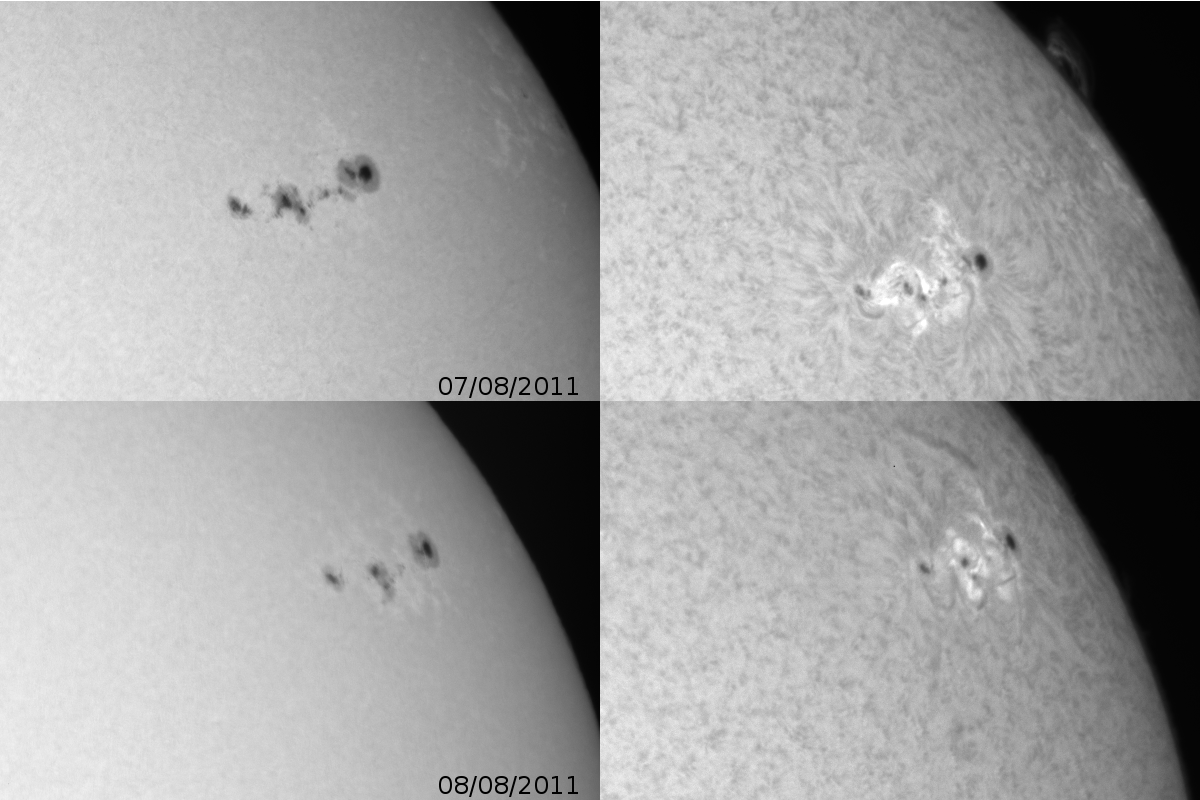
Active region NOAA 11302
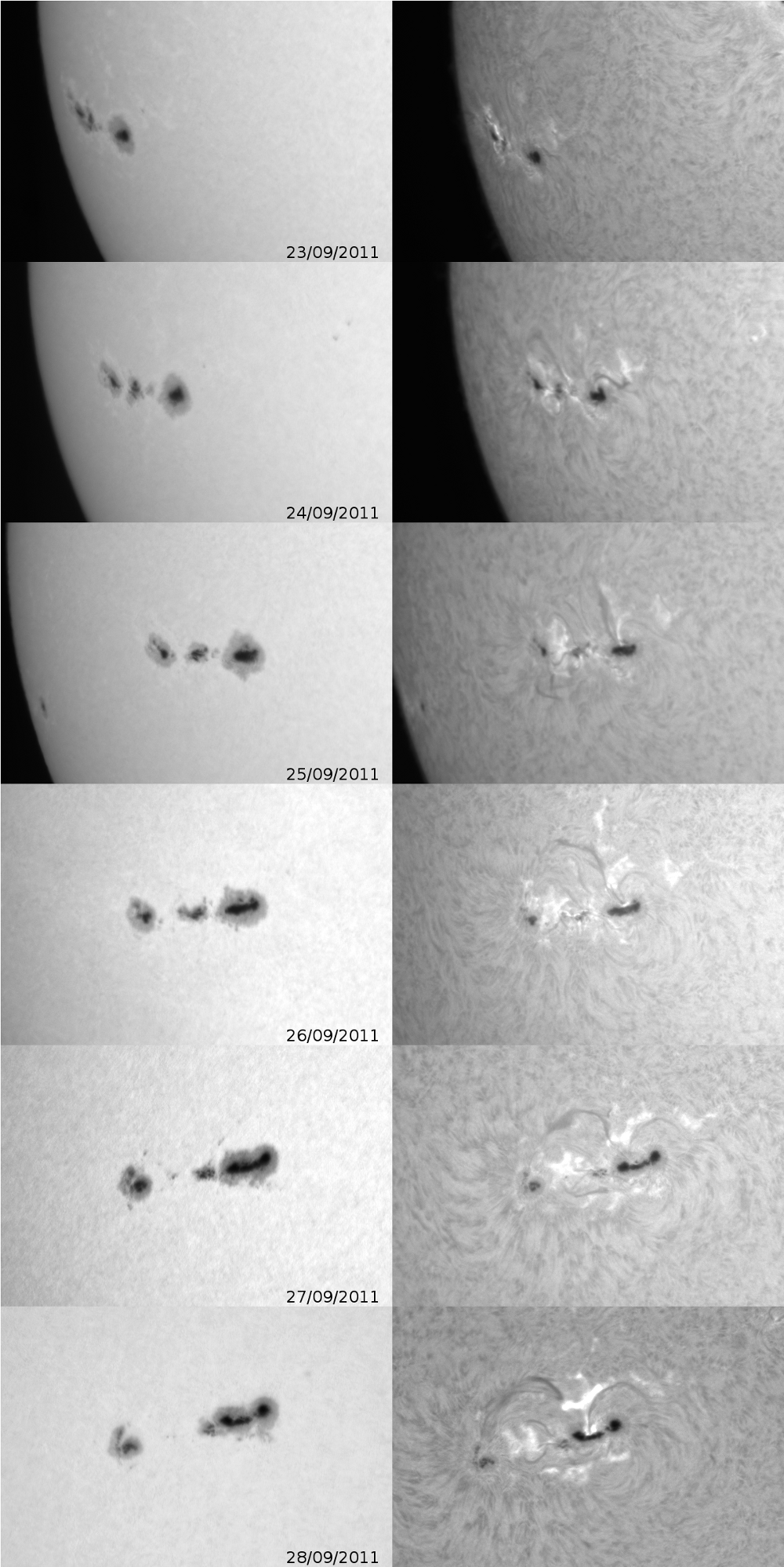
Active region NOAA 11324
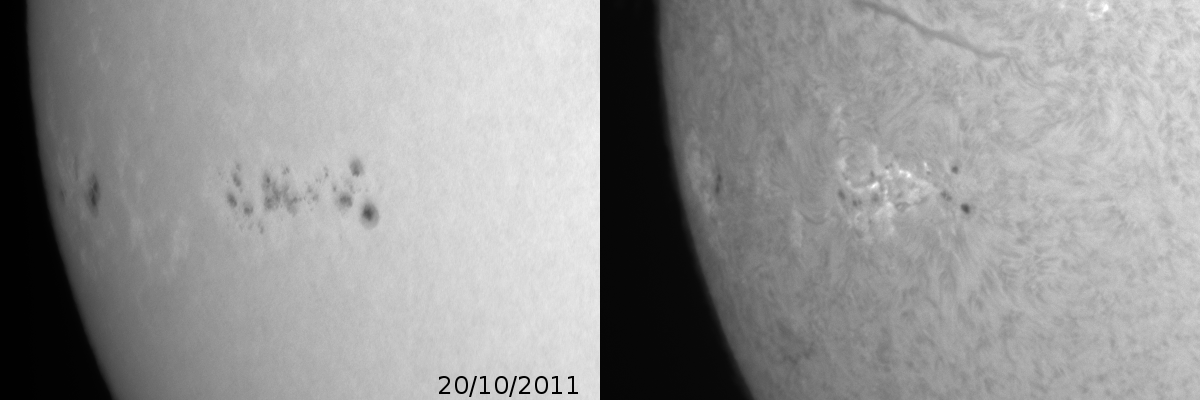
For checking more full-disk USET images of the last solar rotation and beyond, please visit the USET page at: http://www.sidc.be/uset
Seventeen sunspot groups were detected during the week: Catania numbers 27 (NOAA AR 1334), 29 (NOAA AR 1337), 30 (NOAA AR 1338), 31 (NOAA AR 1339), 32 (NOAA AR 1344), 33 (NOAA AR 1340), 34 and 41 (together constituting NOAA AR 1342), 35 and 37 (together constituting NOAA AR 1341), 36 (NOAA AR 1343), 38 and 39 (together constituting NOAA AR 1344), 40 (NOAA AR 1345), 42 (unreported by NOAA), and NOAA ARs 1346 (not reported by Catania during the week; Catania numbers 46 and 47 on November 14) and 1347 (not reported by Catania during the week; Catania number 45 on November 14). Flaring activity at the C-class level was produced by Catania sunspot groups 31, 35, 38, and 45 (NOAA ARs 1339, 1341, 1344, and 1347, respectively).
The strongest flare observed during the week was the M1.1 flare peaking at 13:35 UT in Catania sunspot group 34 (NOAA AR 1342) on November 9. It was accompanied by a type II radio burst observed by Humain. PROBA2/SWAP and SDO/AIA detected associated filament eruption and coronal dimmings indicating the eruption of a CME. A full halo CME was detected by SOHO/LASCO first visible in the LASCO C2 field of view at 13:36 UT. Its speed was around 1000 km/s. The CME-driven shock arrived at the Earth on November 12 (see below).
Another partial halo CME was first visible in the LASCO C2 field of view at 11:36 UT on November 8. It had the angular width of around 120 degrees and speed around 500 km/s. The CME source region was situated at the west limb (Catania number 27, NOAA AR 1334). The data taken by SECCHI/COR2 onboard STEREO A confirmed that a part of this CME was directed towards the Earth. This CME was most probably the driver of the shock detected by ACE on November 11 (see below).
The C4.2 flare peaking at 07:05 UT on November 11 in the Catania sunspot group 38 (NOAA AR 1344) was also associated with a weak partial halo CME first seen in the LASCO C2 field of view at 07:12 UT. Due to the weakness of the halo and its moderate speed (around 700 km/s), no interplanetary counterpart was detected by ACE or SOHO/CELIAS at the moment of writing.
An active region right behind the north-east limb (one of returning NOAA ARs 1330 or 1333) produced a strong limb partial halo CME on November 12 (first appearance in the LASCO C2 field of view 18:36 UT, angular width 200 degrees, speed around 650 km/s). Due to the behind the limb position of its source region, the CME is not expected to be geoeffective.
In the beginning of the week the Earth was situated inside a slow solar wind flow. Geomagnetic conditions were quiet. A weak shock was detected by ACE around 03:00 UT on November 11. It was most probably associated with the partial halo CME on November 8 (see above). As the solar wind speed stayed low (around 430 km/s) and the interplanetary magnetic field (IMF) magnitude reached only moderate values (around 8 nT), no geomagnetic disturbance followed.
Another interplanetary shock was detected by ACE and SOHO/CELIAS around 05:18 UT on November 12. The shock was most probably driven by the ICME corresponding to the halo CME observed on the Sun on November 9. Again, due to moderate values of the solar wind speed (up to 460 km/s) and the IMF magnitude (up to 9 nT), the geomagnetic conditions remained quiet.
Based on a set of 11 CME events we study the impact of projection
effects by tracking CME leading edge features in the plane of sky
(traditional CME tracking) from combined STEREO-SECCHI and SOHO-LASCO
observations up to 20 Rs. By using CME observations from
two vantage points and applying triangulation techniques, the source
region location of the CME on the solar surface was determined
(heliospheric longitude and latitude) to correct for projection effects.
With this information, the directivity and “true” speed of a
CME can be estimated in a simple way. The comparison of the results
obtained from the spacecraft pairs SOHO-LASCO/STEREO-A and
SOHO-LASCO/STEREO-B allows us to study the reliability of the method.
The determined CME source region is generally coincident within <10°.
http://www.spaceweather.eu/en/repository/show?id=166
Using the potential of two unprecedented missions, Solar Terrestrial
Relations Observatory (STEREO) and Reuven Ramaty High-Energy Solar
Spectroscopic Imager (RHESSI), we study three well-observed fast coronal
mass ejections (CMEs) that occurred close to the limb together with
their associated high-energy flare emissions in terms of RHESSI hard
X-ray (HXR) spectra and flux evolution. From STEREO/EUVI and STEREO/COR1
data, the full CME kinematics of the impulsive acceleration phase up to
~4 R sun is measured with a high time cadence of <=2.5
minutes. For deriving CME velocity and acceleration, we apply and test a
new algorithm based on regularization methods. The CME maximum
acceleration is achieved at heights h <= 0.4 R sun, and
the peak velocity at h <= 2.1 R sun (in one case, as small
as 0.5 R sun). We find that the CME acceleration profile and
the flare energy release as evidenced in the RHESSI HXR flux evolve in a
synchronized manner. These results support the "standard" flare/CME
model which is characterized by a feedback relationship between the
large-scale CME acceleration process and the energy release in the
associated flare.
http://www.spaceweather.eu/en/repository/show?id=167
For tracking CMEs from Sun to Earth a new method, based on base difference images from HI observational data is presented.
http://www.spaceweather.eu/en/repository/show?id=168
Presentation of the implementation of a Calcium telescope at Kanzelhöhe Observatory (KSO) at the Hvar Colloquium 2010.
http://www.spaceweather.eu/en/repository/show?id=169
Presentation of the SOTERIA Solar Event Catalogue (SOSEC) at the Hvar Colloquium 2010.
http://www.spaceweather.eu/en/repository/show?id=170
Start : 2011-11-28 - End : 2011-12-02
We are pleased to announce that the Eighth European Space Weather Week will take place at the Palais des Congres, Namur, Belgium between 28th November and 2nd December 2011.This meeting is being jointly organised by the Solar-Terrestrial Centre of Excellence (STCE), ESA, the SWWT and the COST ES0803 communities. The local organisation is done by the STCE. This event will continue to build on the advances made during the first seven European Space Weather Weeks held between 2004 and 2010.Now in its 8th year, the ESWW has grown into the main annual event in the European Space Weather calendar. This year's event will highlight key innovations in space weather research, applications and services. The meeting will also focus on current challenges and actions necessary in moving towards a sustainable Space Weather Infrastructure in Europe able to meet the requirements of a diverse end-user community.Recent Space Weather related activities in the framework of the ESA Space Situational Awareness programme and the EC's 7th Framework Programme will be a key topic. Next stept will be presented with the opportunity for technical discussion. Community input is welcome and encouraged in particular via the SWWT plenary meeting.Website:
Start : 2011-12-05 - End : 2011-12-09
The AGU Fall Meeting is the largest worldwide conference in the geophysical sciences, attracting nearly 20,000 Earth and space scientists, educators, students, and policy makers. This meeting showcases current scientific theory focused on discoveries that will benefit humanity and ensure a sustainable future for our planet.Website: http://sites.agu.org/fallmeeting/
Start : 2012-01-04 - End : 2012-01-07
This open scientific meeting is sponsored by the U.S. National Committee (USNC) of the International Union of Radio Science (URSI). The USNC-URSI is appointed by the National Research Council of The National Academies and represents U.S. radio scientists in URSI. The meeting is held in cooperation with the following IEEE organizations: Antennas and Propagation Society, Circuits and Systems Society, Communications Society, Electromagnetic Compatibility Society, Geoscience and Remote Sensing Society, Information Theory Society, Instrumentation and Measurement Society, Microwave Theory and Techniques Society, and Nuclear Science Society. Papers on any topic in the interest area of a Commission are welcome. Contact the Commission Chairperson or visit the web site for further information.Website: http://www.nrsmboulder.org/
Start : 2012-01-16 - End : 2012-01-17
This Workshop aims to promote the interdisciplinary discussion about topics related to the relationship between solar activity and terrestrial climate variability. It covers the long-term change in the Sun, and its direct and indirect influences upon the heliosphere and the Earth, including the atmosphere and climate. The Workshop consists of invited talks by distinguished speakers, contributed talks, and panel discussions. The deadline of registration and abstract submission is 16th December, 2011. We welcome anyone who is interested in any topics on solar activity and climate changes.Link:
Start : 2012-01-31 - End : 2012-02-03
This meeting is dedicated to the processes in the solar wind and corona in the light of the upcoming Solar Orbiter mission. Over the last three decades there has been astonishing progress in our understanding of the solar corona and the inner heliosphere driven by remote-sensing and in-situ observations. This period of time has seen the first high-resolution X-ray and EUV observations of the corona and the first detailed measurements of the ion and electron velocity distribution functions in the inner heliosphere. Today we know that we have to treat the corona and the wind as one single object, which calls for a mission that is fully designed to investigate the interwoven processes all the way from the solar surface to the heliosphere.Website:
Start : 2012-03-12 - End : 2012-03-16
An overarching theme of the meeting is to cover how different regions in the solar atmosphere are coupled, with a particular focus on the chromosphere, the region where most of the non-thermal energy in the solar atmosphere is deposited. The meeting will focus on quiescence, i.e., the non-flaring, non-eruptive state of the atmosphere in coronal holes, quiet Sun and active regions.The major goals of this meeting are:
Start : 2012-04-18 - End : 2012-04-20
We are hosting a conference celebrating the careers of Prof. George Doschek from NRL and Prof. Tetsuya Watanabe from NAOJ focussing on the topic of Spectroscopy of the Dynamic Sun.George Doschek has played a major part in space solar spectroscopy for many decades. Following a key role in exploiting Skylab data, he made huge contributions to the design and build of instruments on board the P78-1, Yohkoh and Hinode missions, being US PI for the Hinode EIS. His knowledge of spectroscopy is recognized and respected internationally and he has published very many papers on high temperature solar plasmas.Tetsuya Watanabe is a leading spectroscopist in Japan. Following work with stellar atmospheres, he has been involved from the start of Japanese space solar physics with significant roles in the Bragg spectrometers the Tansei 4, Hinotori and Yohkoh missions. He is Japanese PI for Hinode EIS. He has published extensively on solar X-ray and EUV spectra.This conference will focus on recent results using spectroscopy to probe fundamental questions in solar physics.Website:
Start : 2012-04-30 - End : 2012-05-04
As the impact of space weather and climate on daily life is becoming more important, it is timely to discuss the latest reseach on the solar origin of these phenomena. Recent advances in helioseismology have demonstrated that subsurface dynamics are closely associated with aspects of solar activity from the long-term timing of the solar cycle to the short-term eruption of solar flares. The advent of synoptic vector magnetic field measurements is opening up a new path for research on active regions, flares and CME's. Coronal magnetic field measurements should become available in the next 5-10 years, supplying another physical constrain on space weather events.Website:
Start : 2012-05-20 - End : 2012-05-25
Helioseismology and asteroseismology are the only means to investigate the interior of the Sun and stars. They are crucial for understanding the structure and evolution of stars, which produce all chemical elements in the universe heavier than helium, and which host and influence planets which may carry life. Understanding the physics of the Sun's interior is essential for understanding the solar dynamo and consequently for predicting solar magnetic activity, which has a severe impact on the operation of space missions. Understanding the interior of the stars is essential for understanding those astronomical objects that host and influence planets. With the suite of the latest instruments and missions, e.g. BiSON, GONG, SOHO, SDO, Hinode and Picard for solar exploration and MOST, CoRoT, Kepler, BRITE, SONG for stellar and exoplanetary research, the precision on the seismically determined quantities, e.g. flows in the solar interior or the ages and radii of stars will be greatly improved. This will allow creating new knowledge in solar physics and astrophysics and therefore makes the proposed conference particularly timely.Website:
Start : 2012-05-21 - End : 2012-05-23
The purpose of this workshop is to foster the development of tools to interpret current and future measurements of coronal magnetic fields in order to improve our understanding of the Sun and the sources of Space Weather. This is motivated by the anticipated rapid growth over the next decade in our remote sensing capabilities of the coronal plasma. These new capabilities can only be exploited with improvements in our ability to model the polarized radiative transfer through the coronal plasma and by coupling information on the coronal magnetic field and plasma conditions with models extending to the near Earth environment.This workshop will include a wide variety of subjects including, but not limited to, instrumentation, the interpretation of polarimetric signals in EUV and UV emission lines, techniques to mitigate the effects of line-of-sight integration effects of the optically thin corona such as tomographic inversions and forward modeling, models of the polarized radiative transfer at radio wavelengths, extrapolation and MHD modeling of coronal magnetic fields, as well as discussions on how to move forward with coupling these inferences of the coronal plasma with models of heliospheric structure and Space Weather prediction.Website:
Start : 2012-05-31 - End : 2012-06-07
The 2012 Heliophysics Summer School will focus on the science underlying current and future heliophysical missions, including but not limited to MMS, Themis, RBSP, IRIS, SDO, and Solar Probe Plus. After providing students with broad overviews of the solar atmosphere, the solar wind, the Earth’s magnetosphere, and ionosphere, the course will cover the basic concepts and unanswered questions pertaining to magnetic reconnection, shocks, plasma instabilities, turbulence, and heating, and the manner in which these concepts and questions affect our understanding of phenomena such as substorms, radiation belt and chromospheric dynamics, solar wind turbulence and particle heating, and heliospheric shocks.Link:
Start : 2012-06-04 - End : 2012-06-08
During the last thirty years there has been steady progress in our understanding of the influence that space weather has on the state of human health both in Space and at Earth. This development is mainly based on research conducted on humans onboard space stations and spacecrafts, as well as on ground based observations and experimental studies simulating conditions in space. This interdisciplinary field of research requires a wide exchange of expertise in various topics. Only with a global approach it will be possible to establish a mutual understanding, in regard to defining the current state of this research problem as well as identifying what should be pursued in future research activities.Website:
Start : 2012-06-17 - End : 2012-06-22
The Thirteenth International Solar Wind Conference, organized by the
University of Alabama in Huntsville's Center of Space Plasma and Aeronomic
Research (CSPAR) and the the University of California, Berkeley's Space
Sciences Laboratory, will take place at Sheraton Keauhou Resort on Big
Island, Hawaii, USA, from 17 to 22 June 2012. Please note that scientific
sessions will start on Monday 18 June.The conference will conform to the traditional solar wind themes, addressing
the current state of knowledge in the relevant fields of solar and
heliospheric physics. In particular, the conference will focus on the
physics ofthe corona, the origin and acceleration of the solar wind, its
dynamical interactions throughout the heliosphere and the interstellar
medium and its boundaries. The program will be composed of both invited
lectures and contributed talks and posters.Website:
Start : 2012-06-25 - End : 2012-06-29
You will have a noticed the slight re-branding of these workshops from ‘Image’ to ‘Information’ processing. We think it is time to expand the attention of these workshops to discuss more generally how information about the Sun can be derived, stored, shared, transformed and analyzed using appropriate techniques from many other disciplines. We will still be covering image processing and computer vision techniques applied to solar physics, but we will also be including other topics such as machine learning, data mining and new computing strategies. The re-branding simply acknowledges and makes explicit what the community has been doing to determine the physics of the Sun.Link: http://www.sipwork.org/
Start : 2012-07-14 - End : 2012-07-22
The 39th COSPAR Scientific Assembly will be held at the Global Education Centre, 2 Infosys Training Centre Mysore, Karnataka India from 14 - 22 July 2012. This Assembly is open to all bona fide scientists.Website: http://www.cospar-assembly.org/
Start : 2012-08-20 - End : 2012-08-31
Website: http://iau.org/science/meetings/future/general_assemblies/812/
Start : 2012-11-12 - End : 2012-11-16
As we emerge from one of the deepest and longest solar minima on record, with a new and powerful eye on the Sun -SDO- we invite all those with an interest is solar activity to gather in beautiful Palm Cove, Australia to review and assess our current knowledge and understanding of our magnetic star, and to experience the awe and wonder of a total solar eclipse on November 14, 2012.Website: